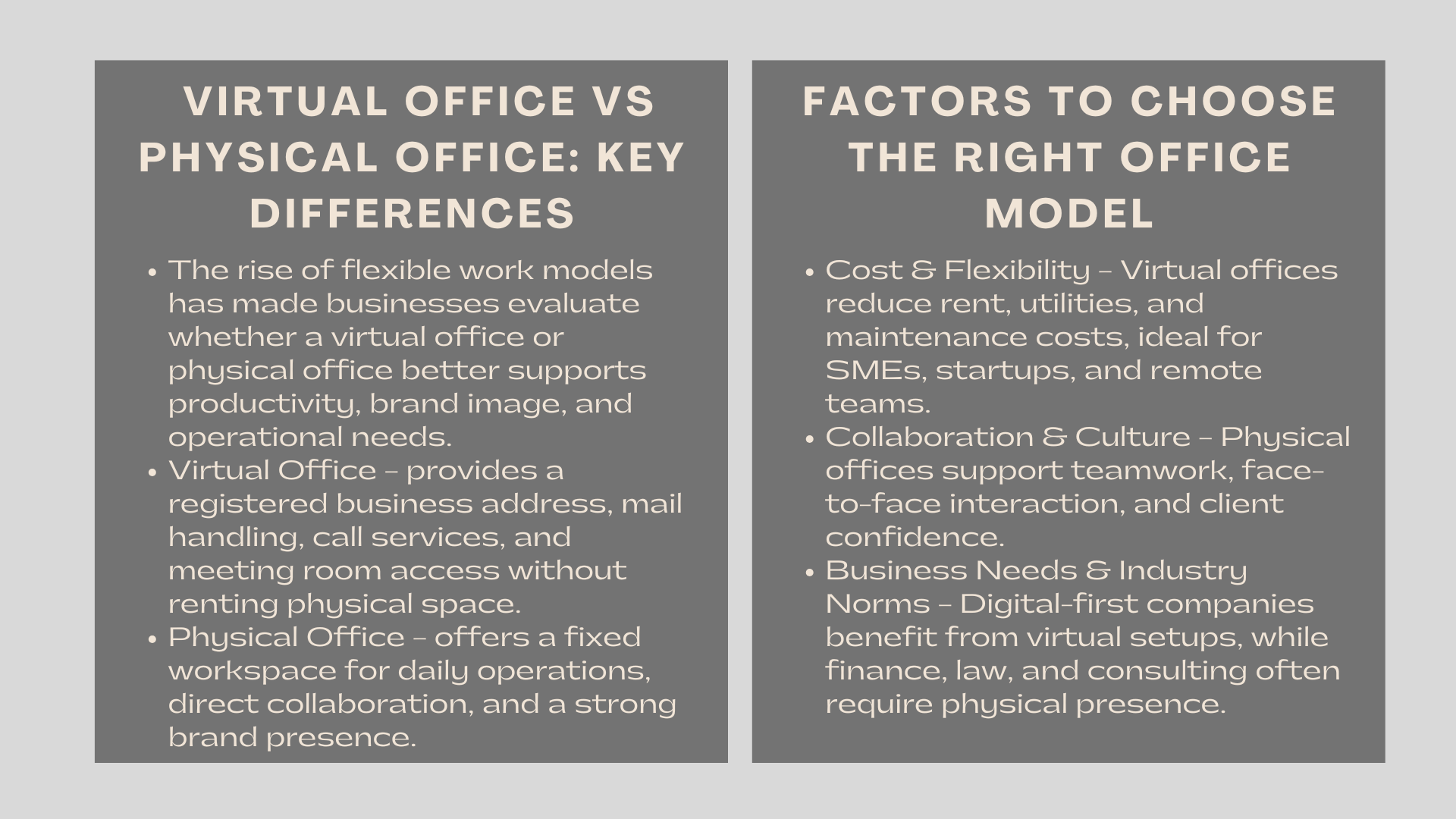Virtual Office vs Physical Office – Which Should You Choose?
Flexibility and cost efficiency have gained critical consideration among business people and corporate leaders in the contemporary business world that is rapidly changing. The choice between the physical office and the virtual office model is a decision that may bring a major impact on the efficiency of operations, productivity of the employees, and brand image. Singapore is an established business hub in the region with modern coworking spaces and high-level digital infrastructure, which means that the businesses find it easier to select the model that suits them the most when setting up an office in Singapore.
This paper will take an in-depth look into the working of both types of offices, their benefits and disadvantages and which considerations are beneficial in guiding organizations to what type of office will work best with their strategic objectives.

1. Learning the Two Office Models.
1.1 The Virtual Office Concept.
A virtual office is one of the services which offers companies a professional address, in-mail service, answering calls and access to meeting spaces without owning a physical work space. It is especially prevalent with startups, freelancers, and international companies interested in having a presence in Singapore and do it on a remote basis.
With the help of comparison between virtual and physical office setups for businesses, it becomes clear that virtual offices cater to companies that prioritize flexibility, digital operations, and low overhead costs. These setups are designed to project professionalism while maintaining the agility of a remote work model.
1.2 What Defines a Physical Office
Physical office, however, provides a special working station, where the employees can join daily and collaborate and conduct operations. It offers direct advantages like physical interaction, in-site management, and orderly environment-three elements that can be used to improve communication and culture in some industries.
The traditional offices also act as a visible representation of stability and credibility especially to businesses that play a significant role in the process of paying clients a visit, conducting confidential talks, or doing manual work.
2. The Benefits of a Virtual Office.
2.1 Cost Efficiency
Costs savings is one of the best merits of virtual offices. Companies are able to eradicate rent, utility, and maintenance bills, and still have a valid corporate presence. This applies especially when the small and medium enterprises (SMEs) or startups are trying to keep overhead to minimal levels especially in the initial growth phases.
Businesses can use the opportunity of outsourcing administrative and communication activities to the companies of the virtual offices to enable the company to invest more in their businesses or in marketing or in the technological sectors.
2.2 Flexibility and Mobility
Virtual offices enable teams to work in any place- at home, internationally or in various localities. This is flexibility that promotes a contemporary, hybrid work culture that prides itself on employee satisfaction and productivity.
There is also easy scaling of the companies and the company can upgrade or downgrade service package based on the needs of the business performance and operational requirements.
2.3 Professional Image
Although in a virtual office a business does not have to be physically located, it still gives an impression of the business. The Singapore address contained in the business cards, websites, and official documents should make it prestigious, which improves credibility. Also, such functions as call handling locally and forwarding mails will make the clients think that the business is well-established and responsive.
3. The Strengths of a Real Office.
3.1 Team Cohesion and Collaboration
The team members co-operate and work together effectively in projects and tasks. With physical offices, there is structure and therefore teamwork, creativity and corporate culture. The day-to-day interactions and unplanned discussions tend to result in quicker resolution of problems, and the bond between the team members.
Although these dynamics are possible to some extent using digital collaboration tools, face-to-face communication can sometimes result in a greater degree of trust and interaction.
3.2 Brand Recognition and Customer perception.
A brick-and-mortar office also may become an image of reliability and dedication. A well designed office in the business district of Singapore would provide a good first impression in businesses that regularly get clients or investors, and the brand name would be strengthened by the office.
It may be of particular use in such industries as finance, law, consulting, and real estate-industries, where trust and personal contact is still at the center of focus.
3.3 Operational Control
Having a separate room, the managers will be able to control the daily operations, secure confidentiality of information, and ensure unchanged quality control. A physical workspace can be non-negotiable in the case of the company that handles tangible items or apparatus such as the logistics or engineering company.
4. There are important factors to consider before making a choice.
4.1 Nature of the Business
Companies that use digital communication extensively, online services or operate in remote international teams can operate efficiently with a virtual office arrangement. On the other hand, a traditional office can be more convenient to those who need physical infrastructure, contact with the customers, or face-to-face cooperation.
4.2 Budget and Growth Stage
Small businesses and startups usually start on virtual offices to keep the expenses minimal and yet have a believable image. As they enlarge and grow, they could switch towards hybrid or physical arrangements to enable them accommodate a larger workforce and a more complicated operation.
4.3 Workforce Preferences
Flexibility is becoming important to modern professionals. Virtual offices can serve as a supportive tool in managing distributed teams in companies that are either remote or hybrid employers, whereas physical workspaces may be retained in companies that place importance on in-office culture.
4.4 Client Expectation and Industry Norms.
Clients can feel at ease communicating at a distance in certain sectors such as technology, creative services, or e-commerce. Nevertheless, in industries where face-to-face meetings continue to be part of the work processes, e.g. in the fields of corporate law or banking, the need to have a physical office in order to establish trust is not always eliminated.
5. The Hybrid Approach – Better of Both Worlds.
Singapore with its competitive and technologically developed surroundings have spawned hybrid office solutions that integrate virtual and physical aspects. Companies may have a virtual office to handle administrative, mail, and compliance functions and rent physical or coworking space to have meetings or work as a team on a case-by-case basis.
Such a model enables companies to remain lean and cost effective and provide a physical presence where it is required. Most of the service providers in Singapore currently provide customized packages where virtual office services are combined and limited use of meeting rooms, coworking desks, or event spaces.
This approach aligns perfectly with choosing between virtual office and traditional workspace solutions, as it offers flexibility for businesses to adapt to changing needs without long-term financial commitments.
6. Real-World Example: Virtual Office Adoption Among SMEs
Virtual offices are rapidly being used by more Singaporean SMEs and foreign startups to create a fast and compliant business presence. To bring an example, a tech company entering the Singapore market can obtain a local business address by a virtual office company, run online business, and hold meetings with clients on an ad-hoc basis by renting meeting rooms.
This arrangement will enable them to meet the requirements of ACRA without incurring high expenses of taking physical leases. As the business will continue to grow, the plan can be increased to the dedicated desks or the hybrid-based coworking facilities- showing how virtual setups can help the company grow and evolve.
7. Regulatory Compliance issues.
Irrespective of the model that the business adopts, it is important that the business attends to the regulatory standards of Singapore. Any company should have the registered business address- virtual office service providers satisfy this need by the law. Nonetheless, the physical offices have to comply with zoning and tenancy laws as well.
Moreover, the businesses must make certain that any operations that are exposed to the client adhere to data privacy, employment, and safety requirements whether operated remotely or in-premise.
Conclusion to Virtual Office vs Physical Office Which Should You Choose
Virtual office or physical office is a matter that has to be appropriately decided on and ultimately depends on the operational requirements of a given company, financial means and the long-term objectives. Virtual offices are flexible, more affordable, and can be set up in a short period of time-they are suitable to startups and remote-first organizations. Physical offices in turn facilitate collaboration, control, and a good corporate culture.
The hybrid solution provides the ideal balance of the two aspects of credibility of a physical address and efficiency of working physically or remotely to many businesses. The trick to the fast-paced and globally connected market of Singapore is not about who has the better option–but what will best fit your future strategic beliefs and vision.




